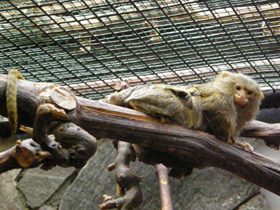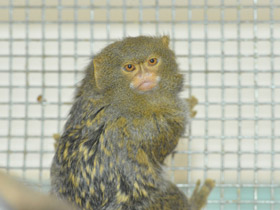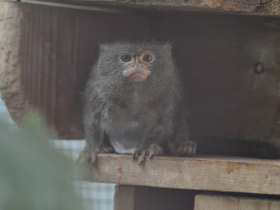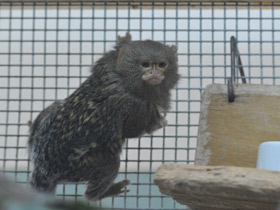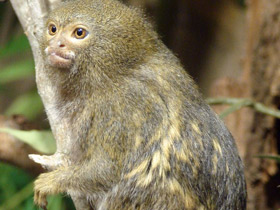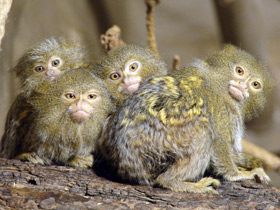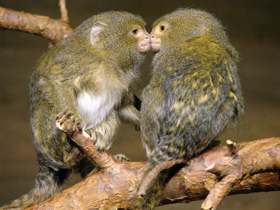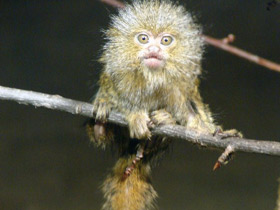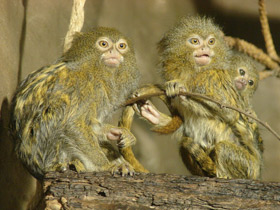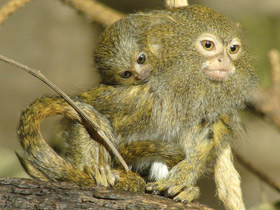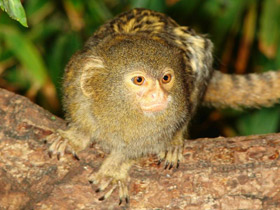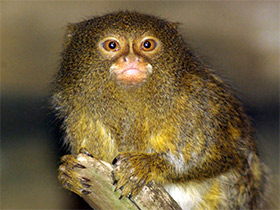The western pygmy marmoset (Cebuella pygmaea)
The western pygmy marmoset (Cebuella pygmaea) is a marmoset species, a very small New World monkey found in the northwestern Amazon rainforest in Brazil, Colombia, Ecuador, and Peru. It was formerly regarded as conspecific with the similar eastern pygmy marmoset, which has whitish underparts. Although the western pygmy marmoset occurs further west than the eastern pygmy marmoset, the primary separators of their ranges are the Amazon River (Solimões River) and Marañón River, with the western occurring to the north of them and the eastern to the south.
Appearance and habitat area
Cebuella pygmaea is a species of platyrrhine primate in the family Callitrichidae. It is characterised by its diminutive size and is the smallest New World monkey species. Its size is only 11 to 15 cm, not counting the tail which measures 17 to 22 cm, and these young weigh between 100 and 150 g. These monkeys live in the Amazon basin, southern Colombia, Ecuador, the northern regions of Peru and Bolivia, and western Brazil.
They usually settle on forest edges, along riverbanks and in seasonally flooded forests. Cebuella pygmaea spends most of its life in trees, but sometimes descends to the ground.
Nutrition
Cebuella pygmaea feeds on tree sap and resin (gum), gnawing the bark with its sharp incisors. Cebuella pygmaea also feeds on insects and other invertebrates, as well as various fruits.
Vocalizations
Due to the natural habitat in the dense Amazonian River basin, the western pygmy marmoset must rely on vocal communication. This marmoset uses trills when it is at close distance, up to 9 m (30 ft), from one another and they use J calls when they are more than 20 m (66 ft) apart. The western pygmy marmoset's "habitat acoustics have shaped the physical structure of the signals used for short and long-range communication". Long-range calls are the only ones that are distinctively heard compared to the trills and J calls, as they produce a lower frequency call at long distances. By using these different calling methods, the pygmy marmoset has developed a way of communicating distances to determine individual locations.
Interestingly, the western pygmy marmoset has been observed to change "the structure of their trill vocalizations in response to pairing with a new mate". Prior to mating, marmosets would display unique trill vocalizations, and after six weeks of pairing, their trills become more homogenous. These same studies also show that these vocal structure changes remained stable three years after pairing.
Social behaviour and reproduction
Cebuella pygmaea live in family groups of several generations of animals. Cebuella pygmaea mark their territory with secretions from special glands, and outsiders from other groups are usually chased away with a cry. After a gestation period of 150 days, the female Cebuella pygmaea usually gives birth to two young. The father and other males in the group help raise the young, carrying them on their backs and bringing them close to the mother to feed them with milk. At the age of two years, young Cebuella pygmaea reach sexual maturity.
Threats and conservation
As of 2015, the western pygmy marmoset (Cebuella pygmaea) has been listed by the IUCN as vulnerable based on the A4cd criteria. Based on their assessments, the population has declined more than 30% since 2009. According to the IUCN, this population decline can be attributed mainly to anthropogenic threats including deforestation, agriculture, mining and settlements. While the distribution area of the western pygmy marmoset is physically large, their niche diet results in a significantly smaller suitable habitat within the area they inhabit. Furthermore, this species has been impacted by the exotic pet trade, specifically in areas of their range which coincide with Ecuador and Peru. Hunting has also traditionally been a stressor to the pygmy marmoset populations, as live capture is a common practice of children and adults of many indigenous communities, as well as being eaten and killed for target practice.
While the western pygmy marmoset is only listen by the IUCN as vulnerable and not yet endangered, many scholars believe that more is needed to protect these animals. Some conservation methods include programs based “on didactic game through which children learn about the ecology, behaviour and conservation of these small primates” with the goal of increasing awareness in order to help preserve pygmy marmosets and their habitats. De La Torre and Morelos-Juarez believe that educating local communities can have positive long-term effects on conservation. For instance, they produced environmental education programs where the intention was to provide children with the tools to be able to reflect how their actions can affect the environment. De La Torre and Morelos-Juarez also have an initiative called “teaching teachers” where teachers were taught to create lessons on the environment and primate protection had positive results among children. Both authors however elude to the fact that empowering and educating local communities is not enough to protect the pygmy marmoset populations.

















